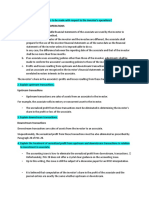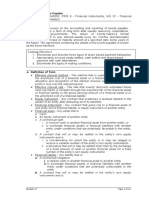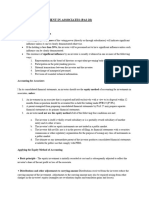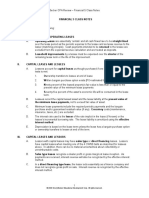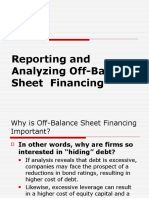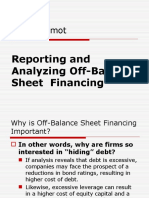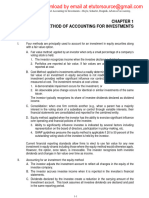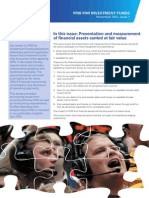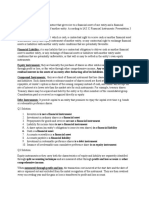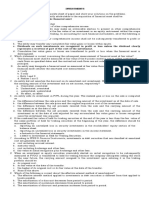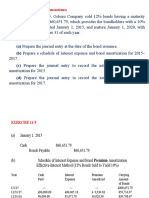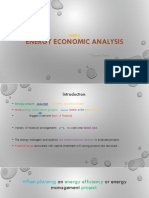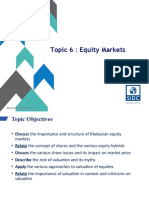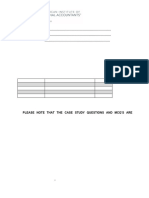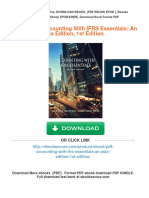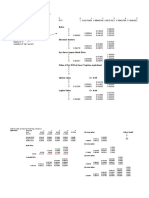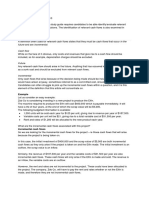0 ratings0% found this document useful (0 votes)
17 viewsFA To Investment Property-Discussion
FA To Investment Property-Discussion
Uploaded by
Mary Rose Castillo AguadoThe document discusses topics related to financial assets including initial and subsequent measurement of bond investments, treatment of bond premiums and discounts, amortization methods, effective interest method, fair value option, reclassification of financial assets, and investment property. It also discusses cash surrender value.
Copyright:
© All Rights Reserved
Available Formats
Download as DOCX, PDF, TXT or read online from Scribd
FA To Investment Property-Discussion
FA To Investment Property-Discussion
Uploaded by
Mary Rose Castillo Aguado0 ratings0% found this document useful (0 votes)
17 views7 pagesThe document discusses topics related to financial assets including initial and subsequent measurement of bond investments, treatment of bond premiums and discounts, amortization methods, effective interest method, fair value option, reclassification of financial assets, and investment property. It also discusses cash surrender value.
Original Title
FA to Investment Property-Discussion
Copyright
© © All Rights Reserved
Available Formats
DOCX, PDF, TXT or read online from Scribd
Share this document
Did you find this document useful?
Is this content inappropriate?
The document discusses topics related to financial assets including initial and subsequent measurement of bond investments, treatment of bond premiums and discounts, amortization methods, effective interest method, fair value option, reclassification of financial assets, and investment property. It also discusses cash surrender value.
Copyright:
© All Rights Reserved
Available Formats
Download as DOCX, PDF, TXT or read online from Scribd
Download as docx, pdf, or txt
0 ratings0% found this document useful (0 votes)
17 views7 pagesFA To Investment Property-Discussion
FA To Investment Property-Discussion
Uploaded by
Mary Rose Castillo AguadoThe document discusses topics related to financial assets including initial and subsequent measurement of bond investments, treatment of bond premiums and discounts, amortization methods, effective interest method, fair value option, reclassification of financial assets, and investment property. It also discusses cash surrender value.
Copyright:
© All Rights Reserved
Available Formats
Download as DOCX, PDF, TXT or read online from Scribd
Download as docx, pdf, or txt
You are on page 1of 7
Financial Asset at Amortized Cost
1. Explain the initial and subsequent measurement of bond
investments.
Bond investment are recognized initially at fair value
plus transaction costs that are directly attributable to the
acquisition.
Subsequent to initial recognition, bond investments
are measured at fair value through profit or loss, at
amortized cost, and at fir value through other
comprehensive income.
2. What is a bond premium and bond discount? Explain the
treatment of premium or discount on trading bond
investment and on bond investments measured ate
amortized cost.
Bond premium is a loss on the part of the bondholder
because the bondholder paid more than what can be
collected on the date of maturity. Loss is not recognized
outright but allocated over the life of the bonds to be offset
against the interest income to be derived from the bond
investment.
Bond discount is a gain on the part of the bondholder
because the bondholder paid less than what can be
collected on the date of maturity. Gain is not recognized
outright but allocated over the life of the bonds to be
added to the interest income derived from the bond
investment.
The treatment of bond premium on trading bond
investments and on bond investments that is measured at
amortized cost is deducted from the interest income while
bond discount is added to interest income.
3. Enumerate the three methods of amortizing bond premium
or discount. Then, explain briefly.
The three methods of amortizing bond premium or
discount are:
Straight line method – This method provides an equal
amount of premium or discount amortization each
accounting period. This method is acceptable only
when the computation will result in periodic interest
income that is not materially different from the
amount that would be computed using effective
interest method.
Bond outstanding method – This method is
applicable to serial bonds and provides for a
decreasing amount of amortization. The same as
straight line method, this method is acceptable only
when the computation will result in periodic interest
income that is not materially different from the
amount that would be computed using effective
interest method.
Effective interest method – Also known as “interest
method” or scientific method. This method provides
for an increasing amount of amortization. Bond
investments shall be classified as financial assets
measured at amortized cost using this method. This
means that any discount or premium must be
amortized using the effective interest method.
Effective Interest Method
1. Define nominal and effective rate.
Nominal rate is the coupon rate or stated rate
appearing on the face of the bond.
Effective rate is the yield rate or market rate which is
the actual or true rate of interest which the bondholder
earns on the bond investment. It is the rate that exactly
discounts estimated future cash payments through the
expected life of the bond or when appropriate, a shorter
period to the net carrying amount of the bond.
2. Explain the effective interest method of amortizing bond
discount and bond premium.
The effective interest method requires the
comparison between interest earned and interest
received. The difference between the two represents
premium or discount amortization. Interest earned is
computed by multiplying the effective rate by the carrying
amount of the bond investment. And the interest received
is computed by multiplying the nominal rate by the face
amount of the bond. The carrying amount of the bond
investment is the initial cost that is increased by periodic
amortization of discount and decreased by periodic
amortization of premium.
3. What do you understand by the “fair value option” in
relation to bond investment?
Investments in bonds can be designated without
revocation as measured at fair value through profit or loss
even if the bonds are held for collection as a business
model. Under this fair value option, all changes in fair
value are recognized in profit or loss. Any transaction cost
incurred is an outright expense.
Reclassification of Financial Asset
1. Explain the requirement for classification of financial
assets between categories.
The entity shall reclassify financial assets only when
it changes the business model for managing the financial
assets. If reclassification occurs, the entity shall apply the
reclassification prospectively from its reclassification date.
The entity shall not restate any previously recognized
gains, losses and interest. The reclassification date is the
first day of the reporting period following the change in
business model that will result in an entity reclassifying
financial asset.
2. What financial assets are permitted to be reclassified?
What are the exemptions from classification of financial
assets?
Only debt investment can be reclassified because the
change in business model is only applicable to debt
investment.
The exemptions from reclassification are equity
investment held for trading or measured at FVPL, equity
investment measured at FVOCI by irrevocable election
and debt investment measured at FVPL by irrevocable
election.
3. Explain the reclassification from:
a. FVPL to amortized cost – The fair value at the
reclassification date becomes the new carrying amount
of financial asset at amortized cost. The difference
between the new carrying amount and the face amount
shall be amortized through profit or loss. A new
effective interest date must be determined based on the
new carrying amount.
b. Amortized cost to FVPL – When an entity reclassifies a
financial asset from amortized cost to fair value through
profit or loss, the fair value is determined at
reclassification date. The difference between the
previous carrying amount and fair value is recognized in
profit or loss.
c. Amortized cost to FVOCI – The financial asset is
measured at fair value at reclassification date. The
difference between the amortized cost carrying amount
and the fair value at reclassification date is recognized
in other comprehensive income. The original effective
interest rate is not adjusted.
d. FVOCI to amortized cost – The fair value at
reclassification date becomes the new amortized cost
carrying amount. The cumulative gain or loss previously
recognized in other comprehensive income is
eliminated and adjusted against the fair value at
reclassification date. The original effective interest rate
is not adjusted.
e. FVPL to FVOCI – The financial asset continues to be
measured at fair value. The fair value at reclassification
date becomes the new carrying amount. A new
effective interest rate must be determined based on the
new carrying amount or fair value at reclassification
date.
f. FVOCI to FVPL – The financial asset continues to be
measured at fair value. The fair value at reclassification
date becomes the new carrying amount. The
cumulative gain or loss previously recognized is
reclassified to profit or loss at reclassification date.
Investment Property
1. Differentiate investment property from owner-occupied
property.
The difference between investment property and
owner-occupied property is that investment property is a
property held by an owner or by the lessee under a
finance lease to earn rentals for capital appreciation or
both while owner-occupied property is held by an owner
for use in the production or supply of goods or services, or
for administrative purposes.
2. Explain the cost model and fair value model of measuring
investment property.
If the entity measures the investment property under
cost model, the asset shall be carried at cost less
accumulated depreciation and any accumulated
impairment loss.
If the entity measures the investment property under
fair value model, the changes in fair value from year to
year are recognized in profit or loss. No depreciation is
recorded for the investment property.
3. Explain the recognition of transfers to and from investment
property.
a. When entity uses the cost model, transfers between
investment property, owner-occupied property and
inventory shall be made at carrying amount.
b. A transfer from investment property carried at fair value
to owner-occupied property or inventory shall be
accounted for at fair value.
c. If owner-occupied property is transferred to investment
property that is to be carried at fair value.
d. If an inventory is transferred to investment property that
is to be carried at fair value.
e. When an investment property under construction is
completed and to be carried at fair value, the difference
between fair value and carrying amount shall be
included in profit or loss.
4. Explain cash surrender value.
Cash surrender value is the amount which the
insurance firm will pay upon the surrender and cancelation of
the life insurance policy. Cash surrender value arises if the
policy is a life policy except in fire, accident and other nonlife
policies, premiums for three full years must have been paid
and the policy is surrendered at the end of the third year or
anytime thereafter. It is classified as noncurrent investment.
You might also like
- Cheat Sheet For Valuation (2) - 1Document2 pagesCheat Sheet For Valuation (2) - 1RISHAV BAIDNo ratings yet
- Solution Manual, Managerial Accounting Hansen Mowen 8th Editions - CH 13Document48 pagesSolution Manual, Managerial Accounting Hansen Mowen 8th Editions - CH 13jasperkennedy089% (19)
- Module 8 - Bonds PayableDocument6 pagesModule 8 - Bonds PayableLui100% (2)
- Unit Number/ Heading Learning Outcomes: Intermediate Accounting Ii (Ae 16) Learning Material: Bonds PayableDocument10 pagesUnit Number/ Heading Learning Outcomes: Intermediate Accounting Ii (Ae 16) Learning Material: Bonds PayableAnthony Ceasar ZambaleNo ratings yet
- What Are The Characteristics of A Bond Investment? AnswerDocument4 pagesWhat Are The Characteristics of A Bond Investment? AnswerAllysa Jane FajilagmagoNo ratings yet
- Investments in Associates Derivatives Agriculture BiologicalDocument14 pagesInvestments in Associates Derivatives Agriculture Biologicaltrixzymae1011No ratings yet
- Bond InvestmentDocument2 pagesBond InvestmentPat RFNo ratings yet
- IA Chap. 19, 20, and 22Document31 pagesIA Chap. 19, 20, and 22Pitel O'shoppeNo ratings yet
- ACC 226 Week 4 To 5 SIMDocument33 pagesACC 226 Week 4 To 5 SIMMireya YueNo ratings yet
- Chapter 9Document18 pagesChapter 9Rubén ZúñigaNo ratings yet
- Smes - Assets Inventories Basic Financial Instruments Investment in Associate Investment PropertyDocument21 pagesSmes - Assets Inventories Basic Financial Instruments Investment in Associate Investment PropertyToni Rose Hernandez LualhatiNo ratings yet
- Financial Assets at Amortized CostDocument8 pagesFinancial Assets at Amortized CostbluemajaNo ratings yet
- M3 Accele 4Document15 pagesM3 Accele 4Julie Marie Anne LUBINo ratings yet
- Copy of 06 Chapter#6 - Debt InvestmentsDocument14 pagesCopy of 06 Chapter#6 - Debt InvestmentsYhenni XiaoNo ratings yet
- #15 Investment in AssociatesDocument3 pages#15 Investment in AssociatesZaaavnn VannnnnNo ratings yet
- Exam NotesDocument9 pagesExam NotesEven JayNo ratings yet
- Nvestment in AssociatesDocument4 pagesNvestment in AssociatesJeric Lagyaban AstrologioNo ratings yet
- CH 9 Lecture NotesDocument14 pagesCH 9 Lecture NotesraveenaatNo ratings yet
- Basics of Financial Management: Birla Institute of TechnologyDocument6 pagesBasics of Financial Management: Birla Institute of TechnologyNilesh kumarNo ratings yet
- Basics of Financial Management: Birla Institute of TechnologyDocument6 pagesBasics of Financial Management: Birla Institute of TechnologyNilesh kumarNo ratings yet
- Basics of Financial Management: Birla Institute of TechnologyDocument6 pagesBasics of Financial Management: Birla Institute of TechnologyNilesh kumarNo ratings yet
- Intermidiate Accounting 2019 Eition Chapter 18Document4 pagesIntermidiate Accounting 2019 Eition Chapter 18Arturo AlfonsoNo ratings yet
- Pas 28Document5 pagesPas 28elle friasNo ratings yet
- Module 1 - Bonds Payable: Dalubhasaan NG Lungsod NG Lucena Intercompany Accounting Part 3 Faye Margaret P. Rocero, CPADocument3 pagesModule 1 - Bonds Payable: Dalubhasaan NG Lungsod NG Lucena Intercompany Accounting Part 3 Faye Margaret P. Rocero, CPABrein Symon DialaNo ratings yet
- Module 17-Bonds-PayableDocument12 pagesModule 17-Bonds-PayableJehPoyNo ratings yet
- Notes For IaDocument3 pagesNotes For IaHassan AdamNo ratings yet
- 5418 Assignment # 01Document24 pages5418 Assignment # 01noorislamkhanNo ratings yet
- Discuss Following Methods of Evaluating Investment Projects. Pay Back Period MethodDocument5 pagesDiscuss Following Methods of Evaluating Investment Projects. Pay Back Period MethodNilesh kumarNo ratings yet
- 2009 F-5 Class NotesDocument3 pages2009 F-5 Class NotesChris Tian FlorendoNo ratings yet
- Chapter 1 Imsm 13th Ed Lecture Notes Chap 1Document39 pagesChapter 1 Imsm 13th Ed Lecture Notes Chap 1Nam PhươngNo ratings yet
- FAR 4308 Investment in AssociatesDocument4 pagesFAR 4308 Investment in AssociatesATHALIAH LUNA MERCADEJASNo ratings yet
- Investment Banking PDFDocument17 pagesInvestment Banking PDFjelagi3068No ratings yet
- Lecture Investment in Debt Securities PDFDocument4 pagesLecture Investment in Debt Securities PDFEomma JeonNo ratings yet
- Investment in AssociateDocument11 pagesInvestment in AssociateElla MontefalcoNo ratings yet
- 06B Investment in Debt SecuritiesDocument4 pages06B Investment in Debt Securitiesrandomlungs121223No ratings yet
- AFS 17th Mar - CapitalisationDocument5 pagesAFS 17th Mar - CapitalisationhardikNo ratings yet
- Fin'l Liab - TheoriesDocument9 pagesFin'l Liab - Theoriesaguevarra121No ratings yet
- Bonds and Long Term LiabilitiesDocument5 pagesBonds and Long Term LiabilitiesDivine CuasayNo ratings yet
- Probiotec Annual Report 2022 6Document8 pagesProbiotec Annual Report 2022 6楊敬宇No ratings yet
- Reporting and Analyzing Off-Balance Sheet FinancingDocument31 pagesReporting and Analyzing Off-Balance Sheet FinancingmanoranjanpatraNo ratings yet
- InvestmentDocument39 pagesInvestmentJames R JunioNo ratings yet
- Hoyle 14e Chapter01 ImsmDocument37 pagesHoyle 14e Chapter01 ImsmMohammed AkramNo ratings yet
- Financial Instrument NotesDocument53 pagesFinancial Instrument NotesKhadija HasanNo ratings yet
- OFF B S Financing Lease PensionDocument31 pagesOFF B S Financing Lease PensionGowri RamachandranNo ratings yet
- Acc003 Summary IA3 C01 Small EntitiesDocument8 pagesAcc003 Summary IA3 C01 Small EntitiesMonique VillaNo ratings yet
- Financial Management Unit 2Document10 pagesFinancial Management Unit 2Janardhan VNo ratings yet
- QuestionsDocument5 pagesQuestionsEl AgricheNo ratings yet
- NC Concept MapDocument3 pagesNC Concept MapMitch MindanaoNo ratings yet
- Int.-Acctg.-3 Valix2019 Chapter28Document25 pagesInt.-Acctg.-3 Valix2019 Chapter28Toni Rose Hernandez LualhatiNo ratings yet
- Advanced AccountingDocument48 pagesAdvanced Accountingsocimedia300No ratings yet
- Plugin Ifrs Investment Funds Issue 1b 686Document0 pagesPlugin Ifrs Investment Funds Issue 1b 686xuhaibimNo ratings yet
- Chapter 5 Bonds and Stock ValuationDocument16 pagesChapter 5 Bonds and Stock ValuationEstores Ronie M.No ratings yet
- Investment in AssociateDocument3 pagesInvestment in AssociatePat RFNo ratings yet
- Ali I18-0221 Quiz#3 SectionBDocument2 pagesAli I18-0221 Quiz#3 SectionBMuhammad Ali MalikNo ratings yet
- Investments and AcquisitionsDocument5 pagesInvestments and AcquisitionsBurhan Al MessiNo ratings yet
- Solution Manual For Fundamentals of Advanced Accounting 7th Edition by HoyleDocument44 pagesSolution Manual For Fundamentals of Advanced Accounting 7th Edition by HoyleJuana Terry100% (43)
- Brown Monochrome Simple Minimalist Research Project Final Defense Presentation TemplateDocument24 pagesBrown Monochrome Simple Minimalist Research Project Final Defense Presentation TemplateFranze CincoNo ratings yet
- CH 1 LectureDocument3 pagesCH 1 LectureviechocNo ratings yet
- UNIT 2 Cost of CapitalDocument11 pagesUNIT 2 Cost of Capitalshreya.fruity23No ratings yet
- InvestmentsDocument2 pagesInvestmentsAlora EuNo ratings yet
- Summary of Michael J. Mauboussin & Alfred Rappaport's Expectations InvestingFrom EverandSummary of Michael J. Mauboussin & Alfred Rappaport's Expectations InvestingNo ratings yet
- Textbook of Urgent Care Management: Chapter 46, Urgent Care Center FinancingFrom EverandTextbook of Urgent Care Management: Chapter 46, Urgent Care Center FinancingNo ratings yet
- Pamela Company #11Document7 pagesPamela Company #11Yassi CurtisNo ratings yet
- ct12005 2012Document282 pagesct12005 2012Patrick MugoNo ratings yet
- 12th Accounts Partnership Test 15 Sept.Document6 pages12th Accounts Partnership Test 15 Sept.SGEVirtualNo ratings yet
- Exercise Chapter 14Document9 pagesExercise Chapter 14hassah fahadNo ratings yet
- Chapter 14 Revised Slides 2022Document36 pagesChapter 14 Revised Slides 2022SSNo ratings yet
- Peter T. Baltes, Swiss Military AcademyDocument10 pagesPeter T. Baltes, Swiss Military AcademydongNo ratings yet
- Unit-2 - Energy Economic AnalysisDocument20 pagesUnit-2 - Energy Economic Analysissharen0% (1)
- Module 7 - Equity MarketsDocument29 pagesModule 7 - Equity MarketsRoshan syedNo ratings yet
- Cost - of - Capital - SlidesDocument23 pagesCost - of - Capital - Slideszaheer9287No ratings yet
- Module 4 - Becore4Document11 pagesModule 4 - Becore4rebecca lisingNo ratings yet
- FINC1302 - Exer&Asgnt - Revised 5 Feb 2020Document24 pagesFINC1302 - Exer&Asgnt - Revised 5 Feb 2020faqehaNo ratings yet
- SAIPA Professional Evaluation Exam June 2022Document26 pagesSAIPA Professional Evaluation Exam June 2022trollipcheriseNo ratings yet
- France Case StudyDocument9 pagesFrance Case StudyTuğba YazıcıNo ratings yet
- Chapter 3 Source of Capital - Handout - 404263880Document22 pagesChapter 3 Source of Capital - Handout - 404263880JAN RAY CUISON VISPERASNo ratings yet
- Get (Ebook PDF) Accounting With IFRS Essentials: An Asia Edition, 1st Edition Free All ChaptersDocument43 pagesGet (Ebook PDF) Accounting With IFRS Essentials: An Asia Edition, 1st Edition Free All Chaptersbecajmajluf100% (5)
- Ho-Lee Binomial TreesDocument9 pagesHo-Lee Binomial TreesirsadNo ratings yet
- Mooncake Adspend Report Jul Sep 2023Document16 pagesMooncake Adspend Report Jul Sep 20232046mayyNo ratings yet
- Chapter 3Document20 pagesChapter 3Hussien AdemNo ratings yet
- Finals Answer KeyDocument11 pagesFinals Answer Keymarx marolinaNo ratings yet
- FFM ArticlesDocument16 pagesFFM ArticlesHasniza HashimNo ratings yet
- Audit ProgramDocument4 pagesAudit ProgramJoey BeringuelaNo ratings yet
- GovREVIEWER in FINALS (Compilatioin of Assignmenst and Exercises)Document74 pagesGovREVIEWER in FINALS (Compilatioin of Assignmenst and Exercises)Hazel Morada100% (1)
- Spartan CaseDocument5 pagesSpartan CaseAshish MalhotraNo ratings yet
- CHAPTER 7 Time Value of Money 1Document16 pagesCHAPTER 7 Time Value of Money 1glizahimmoldangNo ratings yet
- Gonzales CompanyDocument1 pageGonzales CompanyLako Lako FindsNo ratings yet
- Company Acc B.com Sem Iv...Document8 pagesCompany Acc B.com Sem Iv...Sarah ShelbyNo ratings yet
- New Earth Mining: Ashutosh DashDocument16 pagesNew Earth Mining: Ashutosh DashSaurabh ChhabraNo ratings yet





















